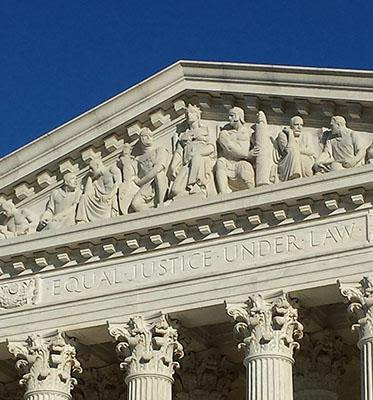Dear Educators,
The Education and Public Programs Team at the Nixon Library is pleased to remind you that the National Archives and Records Administration (NARA) continues to be an excellent source for entertaining and historical content! Simply follow the links below for additional information.
![]()
The United States Supreme Court
![]()

“West Pediment of the Supreme Court Building.” Photograph, Catherine Fitts, From Collection of the Supreme Court of the United States, January 28, 2021, https://www.supremecourt.gov/ (accessed September 15, 2021)
September 24, 2021, marked the 232nd anniversary of the United States Supreme Court. The first Supreme Court, established by President George Washington and the Congress of the United States, came into being on September 24, 1789. When it was initially assembled in 1790, the fundamental order of business was to organize the lesser court system and approve bar appointments. It wasn't until the Court's second year that the justices heard a case (West v. Barnes) and passed down a decision. There have been seventeen chief justices and 103 associate justices confirmed to the Court since 1790.
![]()

The Charters of Freedom displayed in the National Archives Rotunda, Washington DC. National Archives and Records Administration Building. “Founding Documents in the Rotunda for the Charters of Freedom.” Photograph. National Archives Museum, https://museum.archives.gov/founding-documents. Accessed 6 July 2021.
Article III, Section One of the United States Constitution established the Supreme Court in theory, stating, "The judicial Power of the United States, shall be vested in one supreme Court." Still, it was the Judiciary Act of 1789 brought forth by Congress that created the Supreme Court. The size was initially capped at six justices (one chief justice with five associate justices) appointed by the President and confirmed by the Senate, but over the next eighty years, that number increased to a total of nine (one chief justice with eight associate justices) who hold office for life.
Article III, Section Two establishes the Court's jurisdiction, stating, "The judicial Power shall extend to all Cases, in Law and Equity, arising under this Constitution, the Laws of the United States, and Treaties made, or which shall be made, under their Authority..." This jurisdiction applies to any case that involves constitutional or federal law, both original and appellate. The Supreme Court is inherent to our constitutional form of government.
Visit the United States Supreme Court for further information regarding court history, case documents, rulings, as well as a calendar of sessions.
Additionally, through DocsTeach, the National Archives’ online tool for teaching activities through primary resources, we invite you and your students to look further into understanding how the Judicial Branch relates to and exists within our system of government via the teaching activity “The Three Branches of Government.”
Please feel free to contact us at NixonEducation@nara.gov if you have any questions. if you have any questions.
Stayed tuned for regular updates from the Nixon Library Education and Public Programs Team.
![]()
Sincerely,
The Nixon Library Education and Public Programs Team

